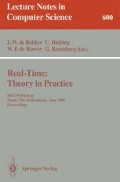Abstract
Duration Calculus was introduced in [1] as a notation to specify real-time systems, and as a calculus to verify theorems about such systems. Its distinctive feature is reasoning about durations of states within any time interval, without explicit mention of absolute time. Duration Calculus, which is an extension of Interval Temporal Logic, was originally designed to reason about real-time requirements for control systems; but it has been used at other levels of abstraction also: for example to give real-time semantics to communicating processes executed on a shared processor configuration and to reason about the correctness of a circuit transformation. The purpose of this paper is to introduce a formal syntax and semantics for Duration Calculus, and to prove its completeness — relative to the completeness of Interval Temporal Logic.
This work is partially funded by ProCoS ESPRIT BRA 3104.
This work is partially funded by the Danish Technical Research Counsil under project RapID.
Also visiting Programming Research Group, Oxford University, England.
On leave of absence from Institute of Software, Academia Sinica, Beijing, China.
Preview
Unable to display preview. Download preview PDF.
References
Zhou Chaochen, C.A.R. Hoare, and A.P. Ravn: A Calculus of Durations. In Information Processing Letters 40(5), 1992, pp. 269–276.
Zhou Chaochen, Michael R. Hansen, A.P. Ravn, and Hans Rischel: Duration Specifications for Shared Processors. In proc. of Symposium on Formal Techniques in Real-Time and Fault Tolerant Systems, Nijmegen, Januar 6–10, 1992. (To appear in the LNCS series.)
Roger Hale: Temporal Logic Programming. In Temporal Logics and their applications, (edited by Antony Galton), Academic Press, 1987, pp. 91–119.
J. Halpern, B. Moskowski, and Z. Manna: A Hardware Semantics based on Temporal Intervals, In proc. ICALP'83, LNCS 154, Springer-Verlag 1983, pp. 278–291.
K.M. Hansen, A.P. Ravn, and H. Rischel: Specifying and Verifying Requirements of Real-Time Systems. In proc. of the ACM SIGSOFT'91 Conference on Software for Critical Systems, New Orleans, December 4–6, 1991, ACM Software Engineering Notes, vol. 15, no. 5, 1991, pp. 44–54.
M.R. Hansen, Zhou Chaochen, and Jorgen Staunstrup: A Real-Time Duration Semantics for Circuits. ProCoS Rep. ID/DTH MRH 7/1, September 1991. (To appear in proc. of TA U'92: 1992 Workshop on Timing Issues in the Specification and Synthesis of Digital Systems, Princeton Univ., NJ, March 1992).
Jifeng He: A Predicative Semantics for a Divergence-Free Programming Language Based on Temporal Intervals. ProCoS Techn. Rep. PRG/OU HJF 8/1, ESPRIT BRA 3104, 1991.
J. Hooman and J Widom: A temporal-logic based compositional proof system for real-time message passing. In proc. PARLE'89, vol. II, LNCS 366, Springer-Verlag 1989, pp. 424–441.
J. Hooman: Specification and Compositional Verification of Real-Time Systems. PhD Thesis 1991, Technical University of Eindhoven.
F. Jahanian and A.K-L. Mok: Safety Analysis of Timing Properties in Real-Time Systems. In IEEE Trans. SE-12(9), 1986, pp. 890–904.
R. Koymans: Specifying real-time properties with metric temporal logic, Journal of Real-time Systems, 2, 1990.
Zhiming Liu: A Probabilistic Duration Calculus. Working Paper, Department of Computer Science, Technical University of Denmark, December 1991.
Ben Moszkowski: A Temporal Logic for Multilevel Reasoning about Hardware, IEEE Computer, vol. 18, no. 2, 1985, pp. 10–19.
A. Pnueli and E. Harel: Applications of temporal logic to the specification of real-time systems. In proc. Symp. Formal Techn. in Real-Time and Fault-Tolerant Systems, LNCS 311, (M. Joseph ed.), 1988, pp. 84–98.
A.P. Ravn and H. Rischel: Requirements Capture for Embedded Real-Time Systems. In Proc. IMACS-IFAC Symposium MCTS, Lille, France, vol. 2, 1991, pp. 147–152.
G.M. Reed and A.W. Roscoe: Metric spaces as models for real-time concurrency. In proc. Mathematical Foundations of Programming, LNCS 298, 1987, pp. 331–343.
S. Schneider: Correctness and Communication of Real-Time Systems. PhD Thesis 1989, Techn. Monograph PRG-84, Oxford Univ. Comp. Lab., March 1990.
Jens U. Skakkebæk: Development of a provably correct system. Master's thesis, Department of Computer Science, Technical University of Denmark, August 1991.
Author information
Authors and Affiliations
Editor information
Rights and permissions
Copyright information
© 1992 Springer-Verlag Berlin Heidelberg
About this paper
Cite this paper
Hansen, M.R., Chaochen, Z. (1992). Semantics and completeness of Duration Calculus. In: de Bakker, J.W., Huizing, C., de Roever, W.P., Rozenberg, G. (eds) Real-Time: Theory in Practice. REX 1991. Lecture Notes in Computer Science, vol 600. Springer, Berlin, Heidelberg. https://doi.org/10.1007/BFb0031994
Download citation
DOI: https://doi.org/10.1007/BFb0031994
Published:
Publisher Name: Springer, Berlin, Heidelberg
Print ISBN: 978-3-540-55564-3
Online ISBN: 978-3-540-47218-6
eBook Packages: Springer Book Archive

